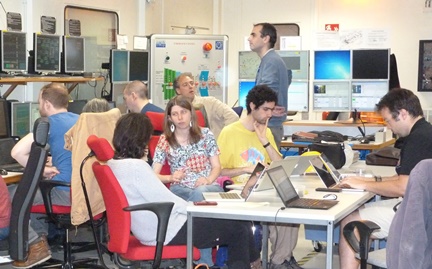Today, for the first time in over two years, protons have collided inside the LHCb detector. Each proton beam had an energy of 450 GeV, which is the value they have when injected from the SPS to the LHC.
Although these collisions are not at the nominal energy of 13 TeV, and therefore not aimed for physics studies, the collected data are useful for precise synchronization of the readout time of different parts of the calorimeters and muon detectors with the time at which different particles originating from the proton-proton collision point traverse them.
The left image shows LHCb physicists in the LHCb control room. The right image displays an event taken today. Click the picture and play with the 3D view of a few recorded events.
In a follow up step, most probably tomorrow, LHCb physicists will inject neon gas into the LHC vacuum tube in order to measure the shape of the proton beam, by seeing where the proton-gas interactions occur. This beam-gas imaging method, used only at LHCb, allows the “luminosity” of the colliding beams to be determined, and is described in the news item of 7 October 2014. The luminosity is a vital component in determining how often different physical processes occur in proton-proton collisions. Measurements of these processes at the record proton-proton collision energy of 13 TeV are the among the first physics goals of LHCb at the restart of data taking in June.


